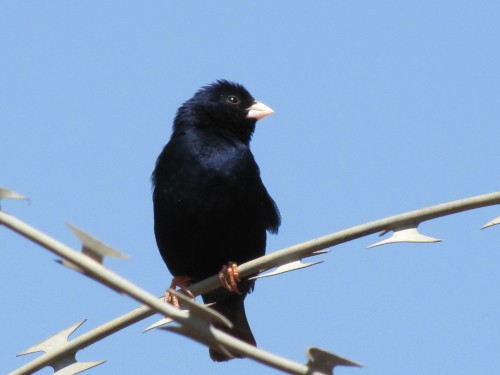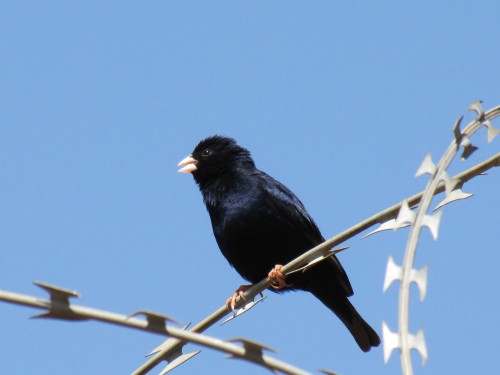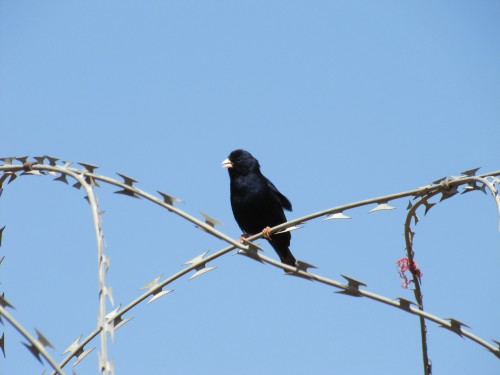Village Indigobird, Addis Ababa, Ethiopia
The Village Indigobird I saw in Addis Ababa, Ethiopia is quite a stunning bird. The black coloured male feathers literally glow in sunlight. Few black coloured birds are quite as brilliant in my opinion. The female – which I didn’t get a chance to photograph – is dull brown, similar to a female House Sparrow.
Village Indigobirds are found over a wide part of Africa south of the Sahara Desert. They are found in bushland, woodlands, cultivated areas and especially around villages – hence the name. Their principal food is seed, especially grain. Being parasitic, the female lays her eggs in the nest of the Red-billed Firefinch (click to see my previous post), so these two species are usually seen in the same area. Unlike the cuckoos, however, the Indigobird does not remove the eggs of the host species.
I should perhaps explain the presence of the razor wire in these photos. The photos were taken inside the campus of the international school, Bingham Academy in Addis Ababa where my daughter was teaching last year. The large school campus is surrounded by a high 3m wall topped in razor wire for security purposes. All visitors and students need to enter through a 24 hour guarded gate. While there have been no incidents that I am aware of, the administrators take security seriously.
Red-billed Firefinch, Addis Ababa, Ethiopia
During my stay in Addis Ababa, Ethiopia last December I frequently saw the beautiful Red-billed Firefinch. This species was very common in the grounds of the school where my daughter was teaching. The extensive grounds were ideal for this seed-eating species and they were often encountered in grassy areas, on or near the school oval and on the lawns next to the classrooms.
The Red-billed Firefinch is also very common throughout sub-Sahara Africa. It is often found in open grassland and cultivated areas. The nest is a domed grass structure with an entrance on the side. The nest is parasitised by the Village Indigobird which was also present on the school campus. (I’ll feature that species in a few days’ time.)
Interestingly I didn’t get any photos of the female of this species. Females are a uniform brown colour all over, except for a red eyebrow and red on the rump.
Grey-headed Sparrow, Ethiopia
Last December we visited our daughter who was teaching in Addis Ababa. While we were there I had quite a few opportunities to do snatches of birding, including some photography. On one occasion we visited a silk shop situated in a private garden. While my wife and daughter were busy shopping I took the opportunity to wander the garden.
This Grey-headed Sparrow was most obliging, posing nicely for the camera in good light. This species of sparrow is widespread in Africa, not only in Ethiopia. After doing a little research on the species I think that this is the sub-species Northern Grey-Headed Sparrow, but I’d like to be corrected by my readers if I’ve got it wrong.
Tawny Pipit, Ethiopia
On my trip to Africa last December I had a few problems identifying some of the birds I saw. This is not unusual when one is in unfamiliar territory. It even happens to me here in Australia when I visit places I may only go occasionally, or for the first time. Contrasting with that is at home where I am immediately aware of any strange bird call in our garden.
While visiting our daughter who was teaching last year in Addis Ababa, we went on a day trip north of the city to a locality known as Portuguese Bridge. Along the way we stopped at a lookout and I managed 2 quick photos of the bird shown today. I am not absolutely certain I’ve got the identification right but the closest I can come is Tawny Pipit.
It was certainly behaving like a pipit, feeding on the ground, constantly bobbing and running along the ground. The area was quite rocky and in parts bare of much grass. I’ve eliminated all of the other pipits found in the area because the throat has no streaking. The only other possibilities (I think) could be a chat or one of the larks.
If any of my readers has more knowledge of the area, or experience with these species, I’d appreciate comments and a more definite ID.
Tacazze Sunbird, Addis Ababa
The Tacazze Sunbird was one of the more spectacular birds I saw in Ethiopia. In its adult breeding plumage it has a deep violet and iridescent colouring but the individuals I saw were mainly in the immature stage or non-breeding plumage, like the bird shown in these photos, taken in a private garden in suburban Addis Ababa.
Several others I saw in the gardens of the school where my daughter was teaching had some colouring, but they were so elusive I struggled to get good photos.














